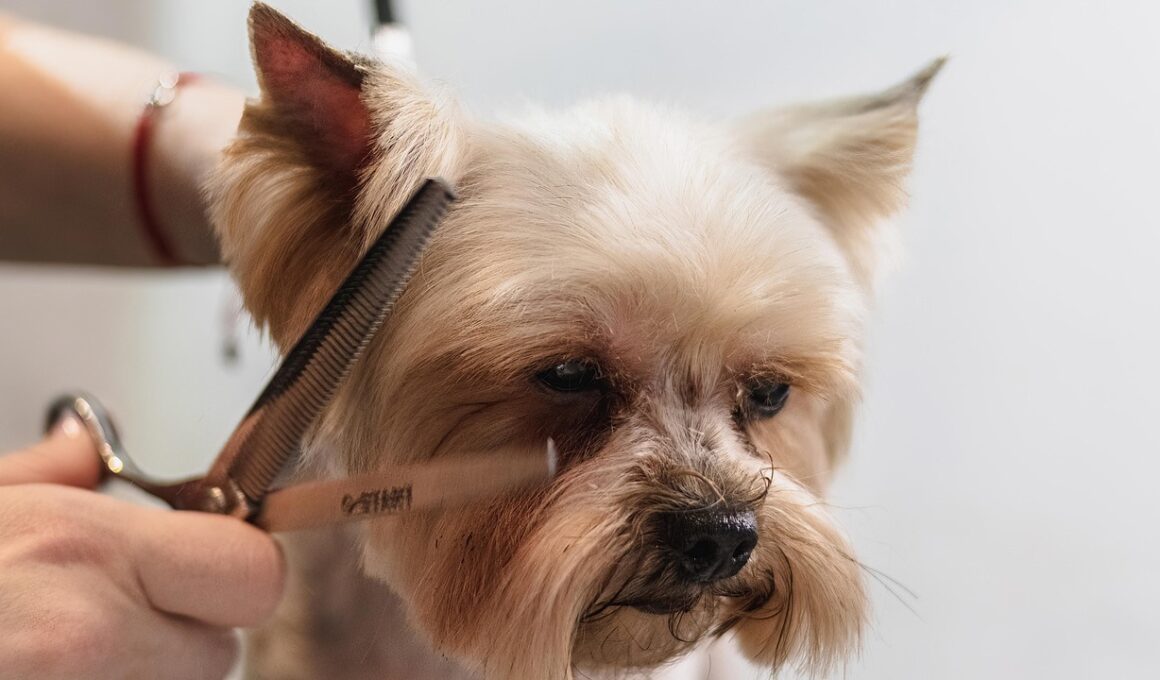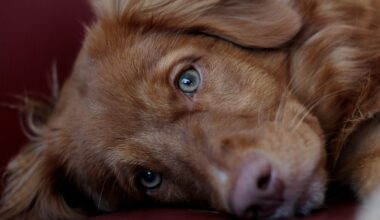Checklist for Preparing to Groom a Difficult Dog
When preparing to groom a difficult dog, creating a checklist ensures a well-structured and organized approach. First, assemble all necessary grooming tools including clippers, brushes, and nail trimmers. A quiet space free from distractions is essential for minimizing stress. Evaluate the dog’s temperament in different environments. Using well-fitting muzzles can prevent bites during the grooming process. Consider using a grooming table to keep the dog secure and stable, allowing for better control. Establish a calming routine by employing soothing techniques such as gentle petting or speaking softly. Remember to be patient and persistent, as difficult dogs may take longer to adjust. Using treats as a reward for good behavior can help build trust and cooperation. Having an assistant can also be beneficial during grooming sessions to help soothe the dog or hold it still. It is essential to prepare mentally for the grooming session and stay calm throughout the process. Taking breaks may also reduce anxiety for both the groomer and the dog, making each session more manageable. Lastly, ensure that you have easy access to the owner for any additional information regarding the dog’s preferences.
Prior to the actual grooming process, assessing the dog’s behavior is vital. Observe how the dog reacts to being touched in various areas, including ears, paws, and tail. Knowing which parts of the body the dog may find sensitive will help you proceed with caution. A thorough pre-groom check allows you to identify any underlying issues that may affect the grooming experience, such as matting or skin irritations. Consider addressing these issues first with the owner before the grooming session. Also, discussing the dog’s history with previous grooming experiences might provide valuable insights. Make sure to use quality and dog-specific grooming products that cater to any unique needs the dog may have. Identifying the right type of shampoo, brush, and conditioner is crucial as some dogs have allergies or skin sensitivities. Read labels carefully and opt for all-natural ingredients whenever possible. Additionally, understand that loud noises from clippers might frighten some dogs, so keeping tools quiet or introducing them gradually may lessen anxiety. The goal is to ensure a positive experience for the dog and the groomer while achieving desired grooming results.
Establishing a Safe Environment
Creating a safe and comfortable environment for the grooming session significantly aids in managing difficult dogs. A dedicated space with non-slippery surfaces helps keep the dog stable and prevents accidents. Ensure proper lighting is available, allowing you to observe the dog’s reactions clearly. Avoid placing any potentially harmful items within reach, including sharp tools. If the dog is heavy or large, it may need to be groomed on the floor rather than a table to reduce injury risk. Utilize calming music or white noise to help mask any startling sounds, promoting a relaxing atmosphere. Be aware of joining a community, a pet group, or training that offers advice on handling difficult dogs. Engaging with fellow dog groomers can provide extra elbow grease for learning new techniques and tips. Furthermore, arranging for sufficient grooming space and a comfortable area for the dog to rest or relax can make a significant difference. Keep water and some toys nearby to maintain a positive emotional state for the dog. Before starting, take a moment to breathe and mentally prepare yourself for the session ahead.
Effective communication plays a crucial role in grooming difficult dogs. Approach the dog slowly and allow it time to acclimatize to your presence. Always speak calmly and reassuringly while maintaining a relaxed body language. Avoid sudden movements as they can startle the dog, amplifying its anxiety. Using treats during the introduction phase will help create a positive association with the groomer. Gradually desensitizing the dog to grooming tools is also crucial. You may begin by allowing the dog to sniff the clippers or brushes before using them directly. Additionally, practice basic commands with the dog in intervals, such as ‘sit’ or ‘stay,’ which helps establish control and communication. Giving the dog ample reassurance during these commands will build both trust and confidence. During grooming, take note of the dog’s stress levels and be prepared to stop if necessary. Break the session into short intervals, rewarding the dog with praise for staying calm. Document any behaviors that require special attention in future sessions. This ongoing communication will lead to improved cooperation and a less stressful experience in subsequent groomings.
Know When to Stop
Recognizing when to pause or stop grooming a difficult dog is essential for the wellbeing of both the groomer and the pet. If at any point the dog exhibits signs of stress, such as growling, barking, or trying to escape, it is crucial to assess the situation. Acknowledging these cues is not a sign of failure; rather, it indicates the need for a modified approach. Allowing ample time for breaks can provide a significant opportunity to reset the dog’s mental state. After a pause, you can return to the grooming session with fresh energy and patience. Additionally, ensuring that the dog has moments of reward throughout the process makes it less likely to resort to aggressive behavior caused by frustration. Consider having the owner involved through brief training sessions prior to grooming. Providing relevant information on the dog’s habits helps create a more effective atmosphere for successful grooming trips. Remember that every dog is unique, and what works for one may not work for another. Hence, flexible strategies are necessary for accommodating individual needs effectively.
Post-grooming care is just as important as preparing to groom a difficult dog. After the session, spend time checking the dog’s skin for irritation or any missed mats. Give the dog plenty of praise and its favorite treats to celebrate successfully completing the grooming. This positive reinforcement can greatly reduce anxiety associated with future grooming sessions. Additionally, remind the owner to maintain the dog’s coat and hygiene between grooming sessions. Recommendations for regular brushings and specific cleaning products can further keep skin issues or matting at bay. Send them home with a detailed care plan that highlights any unique grooming needs and suggested timelines for future visits. Discuss the importance of creating a routine to ensure the dog’s comfort and happiness. Helping owners understand that grooming should not be viewed solely as a necessity but also as a bonding experience can alter their approach. Consistent communication between the groomer and dog owner fosters a stronger relationship enhancing the grooming experience. Ultimately, a well-rounded approach to grooming will lead to improved behavior and harmony between all parties involved.
Conclusion and Final Tips
In conclusion, preparing to groom a difficult dog requires organization, understanding, and patience. Utilizing a thoughtfully crafted checklist enables groomers to manage the grooming process effectively. Building a calm environment, using effective communication, and knowing when to pause all contribute to a successful session. Moreover, continuous feedback from pet owners aids in tailoring each groom to better suite individual dogs. Keeping records of behavior throughout grooming experiences can foster improvement and success over time. Remember to provide post-grooming care and resources for owners to encourage ongoing maintenance. Furthermore, networking with other groomers provides fresh insights and solutions to common challenges faced. Staying informed about current grooming techniques and tools can also improve service quality and client satisfaction. It is essential to take the time to invest in each dog that comes in for grooming. A positive experience can lead to a long-lasting bond between the groomer and the dog, encouraging more stress-free grooming sessions in the future. Finally, practice makes perfect; over time, groomers will feel more comfortable handling difficult dogs, ultimately enhancing their skills and lifestyle.


